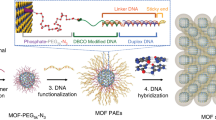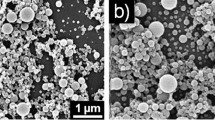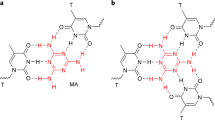Abstract
Since the advent of practical methods for achieving DNA metallization, the use of nucleic acids as templates for the synthesis of inorganic nanoparticles (NPs) has become an active area of study. It is now widely recognized that nucleic acids have the ability to control the growth and morphology of inorganic NPs. These biopolymers are particularly appealing as templating agents as their ease of synthesis in conjunction with the possibility of screening nucleotide composition, sequence and length, provides the means to modulate the physico-chemical properties of the resulting NPs. Several synthetic procedures leading to NPs with interesting photophysical properties as well as studies aimed at rationalizing the mechanism of nucleic acid-templated NP synthesis are now being reported. This progress article will outline the current understanding of the nucleic acid-templated process and provides an up to date reference in this nascent field.
This is a preview of subscription content, access via your institution
Access options
Subscribe to this journal
Receive 12 print issues and online access
$259.00 per year
only $21.58 per issue
Buy this article
- Purchase on Springer Link
- Instant access to full article PDF
Prices may be subject to local taxes which are calculated during checkout




Similar content being viewed by others
References
Burda, C., Chen, X. B., Narayanan, R. & El-Sayed, M. A. Chemistry and properties of nanocrystals of different shapes. Chem. Rev. 105, 1025–1102 (2005).
Cushing, B. L., Kolesnichenko, V. L. & O'Connor, C. J. Recent advances in the liquid-phase syntheses of inorganic nanoparticles. Chem. Rev. 104, 3893–3946 (2004).
Murray, C. B., Kagan, C. R., Bawendi, M. G. Synthesis and characterization of monodisperse nanocrystals and close-packed nanocrystal assemblies. Annu. Rev. Mater. Sci. 30, 545–610 (2000).
Lowenstam, H. A., Weiner, S. On Biomineralization (Oxford Univ. Press, New York, 1989).
Mann, S., Webb, J., Williams, R. J. P. Biomineralization. Chemical and Biochemical Perspectives (Wiley-VCH, Weinheim, 1989).
Bauerlein, E. Biomineralization (Wiley-VCH, Weinheim, 2000).
Mann, S. Molecular tectonics in biomineralization and biomimetic materials chemistry. Nature 365, 499–505 (1993).
Mann, S. et al. Crystallization at inorganic-organic interfaces—biominerals and biomimetic synthesis. Science 261, 1286–1292 (1993).
Heuer, A. H. et al. Innovative materials processing strategies—a biomimetic approach. Science 255, 1098–1105 (1992).
Sakaguchi, T., Burgess, J. G. & Matsunaga, T. Magnetite formation by a sulphate-reducing bacterium. Nature 365, 47–49 (1993).
Dameron, C. T. et al. Biosynthesis of cadmium sulphide quantum semiconductor crystallites. Nature 338, 596–598 (1989).
Mann, S. Molecular recognition in biomineralization. Nature 332, 119–124 (1988).
Barbas, J., Santhanagopalan, V., Blaszczynski, M., Ellis, W. R. & Winge, D. R. Conversion in the peptides coating CdS crystallites in C. Glabrata. J. Inorg. Biochem. 48, 95–105 (1992).
Bae, W. & Mehra, R. K. Metal-binding characteristics of a phytochelatin analog (Glu-Cys)2Gly. J. Inorg. Biochem. 68, 201–210 (1997).
Hoess, R. H. Protein design and phage display. Chem. Rev. 101, 3205–3218 (2001).
Whaley, S. R., English, D. S., Hu, E. L. & Barbara, P. F., Belcher, A. M. Selection of peptides with semiconductor binding specificity for directed nanocrystal assembly. Nature 405, 665–668 (2000).
Sarikaya, M., Tamerler, C., Jen, A. K. Y., Schulten, K. & Baneyx, F. Molecular biomimetics: nanotechnology through biology. Nature Mater. 2, 577–585 (2003).
Levy, R. et al. Rational and combinatorial design of peptide capping ligands for gold nanoparticles. J. Am. Chem. Soc. 126, 10076–10084 (2004).
Izatt, R. M., Christensen, J. J. & Rytting, J. H. Sites and thermodynamic quantities associated with proton and metal ion interaction with ribonucleic acid, deoxyribonucleic acid, and their constituent bases, nucleosides and nucleotides. Chem. Rev. 71, 440–481 (1971).
Martin, R. B. Nucleoside sites for transition metal ion binding. Acc. Chem. Res. 18, 32–38 (1985).
Sigel, H. Interaction of metal-ions with nucleotides and nucleic acids and their constituents. Chem. Soc. Rev. 22, 255–267 (1993).
Klug, S. J. & Famulok, M. All you wanted to know about SELEX. Mol. Biol. Rep. 20, 97–107 (1994).
Wilson, C. & Keefe, A. D. Building oligonucleotide therapeutics using non-natural chemistries. Curr. Opin. Chem. Biol. 10, 607–614 (2006).
Sigel, R. K. O., Freisinger, E. & Lippert, B. Effects of N7-methylation, N7-platination, and C8-hydroxylation of guanine on H-bond formation with cytosine: platinum coordination strengthens the Watson-Crick pair. J. Biol. Inorg. Chem. 5, 287–299 (2000).
Anastassopoulou, J. Metal-DNA interactions. J. Mol. Struct. 651, 19–26 (2003).
Sigel, H. & Griesser, R. Nucleoside 5′-triphosphates: self-association, acid-base, and metal ion-binding properties in solution. Chem. Soc. Rev. 34, 875–900 (2005).
Sigel, H., Massoud, S. S. & Corfu, N. A. Comparison of the extent of macrochelate formation in complexes of divalent metal-ions with guanosine (GMP2−), inosine (IMP2−), and adenosine 5′-monophosphate (AMP2−) - the crucial role of N-7 basicity in metal-ion nucleic base recognition. J. Am. Chem. Soc. 116, 2958–2971 (1994).
de la Fuente, M., Hernanz, A. & Navarro, R. IR and raman study on the interactions of the 5 '-GMP and 5 '-CMP phosphate groups with Mg(II), Ca(II), Sr(II), Ba(II), Cr(III), Co(II), Cu(II), Zn(II), Cd(II), Al(III) and Ga(III). J. Biol. Inorg. Chem. 9, 973–986 (2004).
Burda, J. V., Sponer, J., Leszczynski, J. & Hobza, P. Interaction of DNA base pairs with various metal cations (Mg2+, Ca2+, Sr2+, Ba2+, Cu+, Ag+, Au+, Zn2+, Cd2+, and Hg2+): Nonempirical ab initio calculations on structures, energies, and nonadditivity of the interaction. J. Phys. Chem. B 101, 9670–9677 (1997).
Hinds, S. et al. Nucleotide-directed growth of semiconductor nanocrystals. J. Am. Chem. Soc. 128, 64–65 (2006).
Feldheim, D. L. & Eaton, B. E. Selection of biomolecules capable of mediating the formation of nanocrystals. ACS Nano 1, 154–159 (2007).
Kumar, A. & Mital, S. Electronic properties of Q-CdS clusters stabilized by adenine. J. Colloid Interface Sci. 240, 459–466 (2001).
Kumar, A. & Mital, S. Synthesis and photophysics of purine-capped Q-CdS nanocrystallites. Photochem. Photobiol. Sci. 1, 737–741 (2002).
Kumar, A. & Negi, D. P. S. Photophysics and photocatalytic properties of Cd(OH)2-coated Q-CdS clusters in the presence of guanine and related compounds. J. Colloid Interface Sci. 238, 310–317 (2001).
Kumar, A. & Mital, S. Synthesis and photophysics of 6-dimethylaminopurine-capped Q-CdS nanoparticles—a study of its photocatalytic behavior. Int. J. Photoen. 6, 61–68 (2004).
Green, M., Taylor, R. & Wakefield, G. The synthesis of luminescent adenosine triphosphate passivated cadmium sulfide nanoparticles. J. Mater. Chem. 13, 1859–1861 (2003).
Green, M., Smith-Boyle, D., Harries, J. & Taylor, R. Nucleotide passivated cadmium sulfide quantum dots. Chem. Commun. 4830–4832 (2005).
Dooley, C. J., Rouge, J., Ma, N., Invernale, M. & Kelley, S. O. Nucleotide-stabilized cadmium sulfide nanoparticles. J. Mater. Chem. 17, 1687–1691 (2007).
Green, M., Smyth-Boyle, D. Directed growth of gold nanostructures using a nucleoside/nucleotide. J. Mater. Chem. 17, 3588–3590 (2007).
Zhao, W., Gonzaga, F., Li, Y. & Brook, M. A. Highly stabilized nucleotide-capped small gold nanoparticles with tunable size. Adv. Mater. 19, 1766–1771 (2007).
Coffer, J. L. & Chandler, R. Mater. Res. Soc. Symp. Proc. 206, 527 (1991).
Bigham, S. R. & Coffer, J. L. Deactivation of Q-Cds photoluminescence through polynucleotide surface binding. J. Phys. Chem. 96, 10581–10584 (1992).
Coffer, J. L., Bigham, S. R., Pinizzotto, R. F. & Yang, H. Characterization of quantum-confined CdS nanocrystallites stabilized by deoxyribonucleic acid (DNA). Nanotechnology 3, 69 (1992).
Bigham, S. R. & Coffer, J. L. The influence of adenine content on the properties of Q-Cds clusters stabilized by polynucleotides. Colloids Surf. A 95, 211–219 (1995).
Bigham, S. R. & Coffer, J. L. Thermochemical passivation of DNA-stabilized Q-cadmium sulfide nanoparticles. J. Cluster Sci. 11, 359–372 (2000).
Li, X. & Coffer, J. L. Effect of pressure on the photoluminescence of polynucleotide-stabilized cadmium sulfide nanocrystals. Chem. Mater. 11, 2326–2330 (1999).
Berti, L., Alessandrini, A., Bellesia, M. & Facci, P. Fine-tuning nanoparticle size by oligo(guanine)n templated synthesis of CdS: an AFM study. Langmuir 23, 10891–10892 (2007).
Ma, N., Yang, J., Stewart, K. M. & Kelley, S. O. DNA-Passivated CdS nanocrystals: luminescence, bioimaging, and toxicity profiles. Langmuir 23, 12783–12787 (2007).
Jiang, L. et al. The coordination sites of phosphorothioate oligoG10 with Cd2+ and CdS nanoparticles. New J. Chem. 27, 823–826 (2003).
Jin, J., Jiang, L., Chen, X., Yang, W. S. & Li, T. J. Construction of CdS nanoparticle chain on DNA template. Chin. J. Chem. 21, 208–210 (2003).
Dittmer, W. U. & Simmel, F. C. Chains of semiconductor nanoparticles templated on DNA. Appl. Phys. Lett. 85, 633–635 (2004).
Richter, J. Metallization of DNA. Physica E 16, 157–173 (2003).
Gu, Q. et al. DNA nanowire fabrication. Nanotechnology 17, R14–R25 (2006).
Petty, J. T., Zheng, J., Hud, N. V. & Dickson, R. M. DNA-templated Ag nanocluster formation. J. Am. Chem. Soc. 126, 5207–5212 (2004).
Ritchie, C. M. et al. Ag nanocluster formation using a cytosine oligonucleotide template. J. Phys. Chem. C 111, 175–181 (2007).
Shemer, G. et al. Chirality of silver nanoparticles synthesized on DNA. J. Am. Chem. Soc. 128, 11006–11007 (2006).
Berti, L., Alessandrini, A. & Facci, P. DNA templated photoinduced silver deposition. J. Am. Chem. Soc. 127, 11216–11217 (2005).
Berti, L., Alessandrini, A., Menozzi, C. & Facci, P. Controlled DNA-templated metal deposition: Towards ultra-thin nanowires. J. Nanosci. Nanotech. 6, 2382–2385 (2006).
Gu, Q., Cheng, C. D., Suryanarayanan, S., Dai, K. & Haynie, D. T. DNA-templated fabrication of nickel nanocluster chains. Physica E 33, 92–98 (2006).
Gugliotti, L. A., Feldheim, D. L. & Eaton, B. E. RNA-mediated metal-metal bond formation in the synthesis of hexagonal palladium nanoparticles. Science 304, 850–852 (2004).
Gugliotti, L. A., Feldheim, D. L. & Eaton, B. E. RNA-mediated control of metal nanoparticle shape. J. Am. Chem. Soc. 127, 17814–17818 (2005).
Liu, D. G. et al. RNA-mediated synthesis of palladium nanoparticles on Au surfaces. Langmuir 22, 5862–5866 (2006).
Ma, N., Dooley, C. J. & Kelley, S. O. RNA-templated semiconductor nanocrystals. J. Am. Chem. Soc. 128, 12598–12599 (2006).
Kumar, A. & Jakhmola, A. RNA-mediated fluorescent Q-PbS nanoparticles. Langmuir 23, 2915–2918 (2007).
Levina, L. et al. Efficient infrared-emitting PbS quantum dots grown on DNA and stable in aqueous solution and blood plasma. Adv. Mater. 17, 1854–1857 (2005).
Wang, X. et al. Synthesis and characterization of peptide nucleic acid-platinum nanoclusters. Nanotechnology 17, 1177–1183 (2006).
Seidel, R., Ciacchi, L. C., Weigel, M., Pompe, W. & Mertig, M. Synthesis of platinum cluster chains on DNA templates: Conditions for a template-controlled cluster growth. J. Phys. Chem. B 108, 10801–10811 (2004).
Ciacchi, L. C., Mertig, M., Seidel, R., Pompe, W. & De Vita, A. Nucleation of platinum clusters on biopolymers: a first principles study of the molecular mechanisms. Nanotechnology 14, 840–848 (2003).
Yin, Y. & Alivisatos, A. P. Colloidal nanocrystal synthesis and the organic–inorganic interface. Nature 437, 664–670 (2005).
Bittker, J. A., Phillips, K. J. & Liu, D. R. Recent advances in the in vitro evolution of nucleic acids. Curr. Opin. Chem. Biol. 6, 367–374 (2002).
Fischler, M. et al. Formation of bimetallic Ag-Au nanowires by metallization of artificial DNA duplexes. Small 3, 1049–1055 (2007).
Hammond, D. M. et al. DNA photography: An ultrasensitive DNA-detection method based on photographic techniques. Angew. Chem. Int. Edn 46, 4184–4187 (2007).
Burley, G. A. et al. Directed DNA metallization. J. Am. Chem. Soc. 128, 1398–1399 (2006).
Franzen, S., Cerruti, M., Leonard, D. N. & Duscher, G. The role of selection pressure in RNA-mediated evolutionary materials synthesis. J. Am. Chem. Soc. 29, 15340–15346 (2007).
Author information
Authors and Affiliations
Corresponding authors
Rights and permissions
About this article
Cite this article
Berti, L., Burley, G. Nucleic acid and nucleotide-mediated synthesis of inorganic nanoparticles. Nature Nanotech 3, 81–87 (2008). https://doi.org/10.1038/nnano.2007.460
Issue Date:
DOI: https://doi.org/10.1038/nnano.2007.460
This article is cited by
-
Physical properties and pharmacological applications of Co3O4, CuO, NiO and ZnO nanoparticles
World Journal of Microbiology and Biotechnology (2023)
-
Insight on metal ions inducing chiral self-assembly of DNA in silica mineralization
Nano Research (2023)
-
Nucleobase, nucleoside, nucleotide, and oligonucleotide coordinated metal ions for sensing and biomedicine applications
Nano Research (2022)
-
Synthesis and applications of anisotropic nanoparticles with precisely defined dimensions
Nature Reviews Chemistry (2020)
-
Development of fluorescence oligonucleotide probes based on cytosine- and guanine-rich sequences
Scientific Reports (2020)



